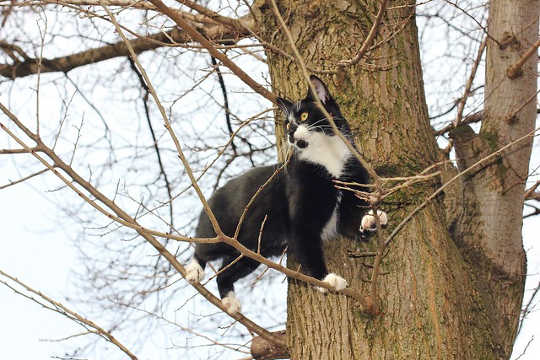
Photo credit: Radarsmum67, Flickr
What’s wrong with reality? A friend is disappointed in love. He tells me, “It didn’t turn out like the picture in my head.” The power lines alongside the tree-dotted highway slide against the sky like an empty bar of sheet music. “Love,” he says, “isn’t what I thought it was.”
From the car radio, a calm voice reports that the stock of a well-known company “fell sharply today, after failing to meet analysts’ expectations.” The company is by most definitions successful: profitable, inventive, and a massive employer. But the market treats it as a failure because its actual growth has not matched the projected growth that an analyst forecasted a year ago. Therefore the valuation of the company drops.
The company’s executives scurry around trying to find ways to convince the market that they are still “innovating” and squeezing more “productivity” out of a business that was already in healthy shape. The performance of the business is secondary to the notated version in the plans and projections.
Or if the company exceeds expectations, it sets up new expectations for more and more growth, which will be disappointed in the coming year. On another day, a wholesale drop in markets occurs because “the growth of jobs in July turned out to be disappointing.” The disappointment that events had not matched economists’ projections overrode the fact that more people actually had jobs. The expectation, an abstract mental model, is considered more real than reality.
Experts discuss what it is about reality that fell short. We frown when the numbers drop and smile when they rise. We have an understandable desire to predict and control, to notate events and expect them to follow a script. If only life would cooperate!
One expectation that is always disappointed is the unnatural, antibiological belief that a living entity, like a company or the economic activity of people, should be able to keep growing forever at an ever-higher rate of speed.
The Constant Mutation Of Is
The radio makes me think of something I wish I had told my friend: sometimes the love that we receive is not the love we wanted. Or once we receive it, it doesn’t feel how we imagined it would feel. Sometimes when we express our love to people, they do not react the way we thought they would, or say the words we hoped to hear them say.
This is the career I expected to have. This is the way I expected my nation to progress. This is the friend I expected you to be. This is how a book proposal or business plan should look. This is how a pop song or a concerto should sound. This is the way it’s supposed to be…
How often do we create a piece of art and have it turn out like the picture in our head? Even if we have a blueprint, making that idea work with real materials and real people changes it. And after we have made it, it keeps changing. Words that were fitting and powerful yesterday can fade and decay tomorrow. The same is true of stones, of cathedrals. Finished buildings bend, decay, get destroyed in wars, or restored in new forms.
There is no way that anything is supposed to be. There is only the constant mutation of is.
There Is No "The"
A revered classical violinist says that she strives to be “the servant of the music” — which she defines as being “the servant of the composer’s intentions.” She refers to the music: a skilled artist acting as a vehicle or conduit for the thoughts and feelings of another artist. But where are the composer’s intentions? Supposedly they are encoded in the score. Is it the original manuscript, or the first published edition, or the composer’s revised edition? A later artist or scholar’s reconstruction? Whose fingering marks and slurs and tempo suggestions made it into which edition? What kinds of instruments do we use — historical or modern — and how do we set them up?
The musician has no choice but to put herself into the performance. The performances we most adore, even those of fully scripted classics, reflect the personalities and the collaboration between fellow musicians and their connection with the audience. Each performance of a play, even with the same actors, is a different enactment for a different audience with a somewhat different atmosphere.
If we play Shakespeare, which variorum edition do we use? Do we play Romeo and Juliet dressed in ruffs and hosen and codpieces? Do we play it dressed up as modern-day gangbangers? Do we play A Midsummer Night’s Dream as medieval fairies or space aliens? Which is more realistic?
We speak of the Bible, but there is no the. There are many versions and translations coming from so many sources, variations of books that have been canonized or rejected, forgotten and found again centuries later. The first books of the Old Testament arose from four textual traditions that were edited and tangled together in the fifth through first centuries BCE: like shuffling four decks of cards into one. Four texts, four styles, four emphases — and four very different gods. The first chapter of Genesis refers to God as Elohim — plural. The second chapter refers to the Lord, the idea of king or emperor projected onto the cosmos.
The Old Testament god Yahweh creates people and sets up the rules for their world. A divine score, notated in stone. He is the architect, laying plans, drawing lines, defining the Way It’s Supposed to Be. Yet soon enough his creatures start disobeying, with minds and desires of their own. They do not follow the sharp lines of the plan laid out for them but instead behave unpredictably and spontaneously. Design, after all, no matter how thoughtful, is always imperfect.
When his creations don’t behave as he wished, Yahweh becomes angry, punishes his creatures, wipes them out, and starts over. But they keep disobeying. That is why the Old Testament is so full of smiting. The outline, the plan, the architectural drawing is incessantly grown over by the intricately fuzzy processes of life.
Suffering: Clinging To “This Is How Things Must Be”
How can we learn to alter our view so that we accept that we change, go off in unplanned directions, make mistakes? How can we view growth and decay, joy and pain, as part of an indissoluble continuum?
There is an old Sanskrit word, dukkha, which refers to frustration or a feeling of unsatisfactoriness. Buddhists speak of the First Noble Truth, which is sometimes mistranslated into English as “Life is suffering.” The original statement is Upadana panca skandha dukkha, “Clinging to the five skandhas is frustrating.” The skandhas are the components that make up our physical and mental existence.
We cannot be identified with our parts, because our parts keep changing, and their relationship to everyone else’s parts keeps changing. Life is not suffering. Clinging to forms that we try to predict and control — “this is how things must be” — that is the prescription for suffering.
The way reality unfolds can seem so unsatisfactory; desire creates the conditions for its own disappointment. Dukkha is the elongation between how things are and the way they’re supposed to be. We expect the things to conform to the ideas. Of course that produces disappointment or suffering. How could it not?
To improvise is to act in accordance with what is happening now, with who you are now, with who your companions are. At the same time, we realize that this now flows within a long sequence of nows.
To improvise is to find the pattern in these happenings and develop it into something interesting, without expecting that it will turn out a certain way. Notice that pattern, amplify and share it where possible, and let it go when the time comes.
This Is Not The Way It’s Supposed To Be
My then nineteen-year-old son Greg texted me from New York that it was nearly 90 degrees in late October. Same here in Virginia. He wrote, “It’s pretty crazy how exponentially worse it gets every year. It wasn’t like this at all last year and it was still an unbelievably warm year for New York. It’s not this gradually advancing thing at all anymore.”
We can physically feel that the Earth’s atmosphere is sick. Human beings have known for many years that our activities are damaging the global climate, yet we have not responded.
Presenting our children with the challenge of living in a biosphere that has been increasingly poisoned — this is not the way it’s supposed to be. Presenting our children with a world poisoned by greed, hate, and delusion — this is not the way it’s supposed to be.
Greg’s text intruded on me as I was copyediting this chapter written long before. This may not have been the way the chapter was supposed to end before that text arrived, but it is now.
We live in a world of impermanence, imperfection, and improvisation. We need to do some fast reimagining of what human life can look like and be. Even more important, we need to accept the realities of our situation. The arts, sciences, technologies — formats of human relations and ethics that have carried us this far — need to be constantly reexamined and recalibrated in relation to the context that surrounds us, in this time, in this place.
©2019 by Stephen Nachmanovitch.
All Rights Reserved. Excerpted with permission.
Publisher: New World Library. www.newworldlibrary.com
Article Source
The Art of Is: Improvising as a Way of Life
by Stephen Nachmanovitch “The Art of Is is a philosophical meditation on living, living fully, living in the present. To the author, an improvisation is a co-creation that arises out of listening and mutual attentiveness, out of a universal bond of sharing that connects all humanity. Drawing from the wisdom of the ages, The Art of Is not only gives the reader an inside view of the states of mind that give rise to improvisation, it is also a celebration of the power of the human spirit, which — when exercised with love, immense patience, and discipline — is an antidote to hate.” — Yo-Yo Ma, cellist (Book is also available in Kindle format. Audiobook, and MP3 CD)
“The Art of Is is a philosophical meditation on living, living fully, living in the present. To the author, an improvisation is a co-creation that arises out of listening and mutual attentiveness, out of a universal bond of sharing that connects all humanity. Drawing from the wisdom of the ages, The Art of Is not only gives the reader an inside view of the states of mind that give rise to improvisation, it is also a celebration of the power of the human spirit, which — when exercised with love, immense patience, and discipline — is an antidote to hate.” — Yo-Yo Ma, cellist (Book is also available in Kindle format. Audiobook, and MP3 CD)
For more info and/or to order this book, click here.
About the Author
 Stephen Nachmanovitch, PhD performs and teaches internationally as an improvisational violinist, and at the intersections of music, dance, theater, and multimedia arts. In the 1970s he was a pioneer in free improvisation on violin, viola and electric violin. He has presented master classes and workshops at many conservatories and universities, and has had numerous appearances on radio, television, and at music and theater festivals. He has collaborated with other artists in media including music, dance, theater, and film, and has developed programs melding art, music, literature, and computer technology. He has created computer software including The World Music Menu and Visual Music Tone Painter. He is the author of Free Play (Penguin, 1990) and The Art of Is (New World Library, 2019). Visit his website at http://www.freeplay.com/
Stephen Nachmanovitch, PhD performs and teaches internationally as an improvisational violinist, and at the intersections of music, dance, theater, and multimedia arts. In the 1970s he was a pioneer in free improvisation on violin, viola and electric violin. He has presented master classes and workshops at many conservatories and universities, and has had numerous appearances on radio, television, and at music and theater festivals. He has collaborated with other artists in media including music, dance, theater, and film, and has developed programs melding art, music, literature, and computer technology. He has created computer software including The World Music Menu and Visual Music Tone Painter. He is the author of Free Play (Penguin, 1990) and The Art of Is (New World Library, 2019). Visit his website at http://www.freeplay.com/

























